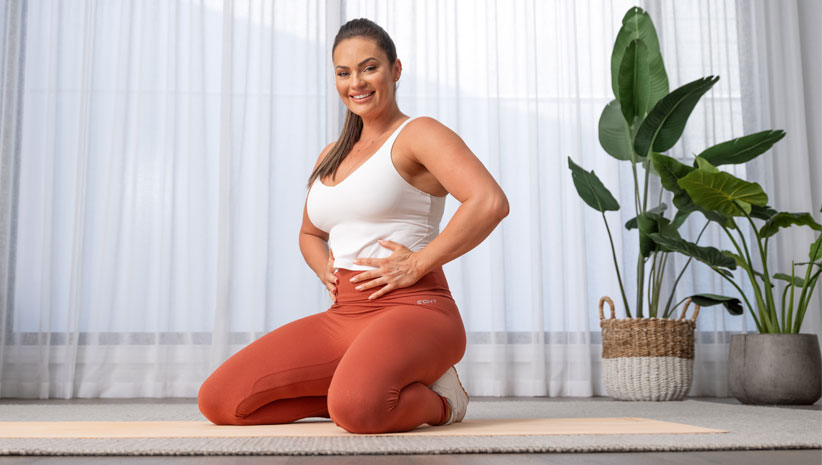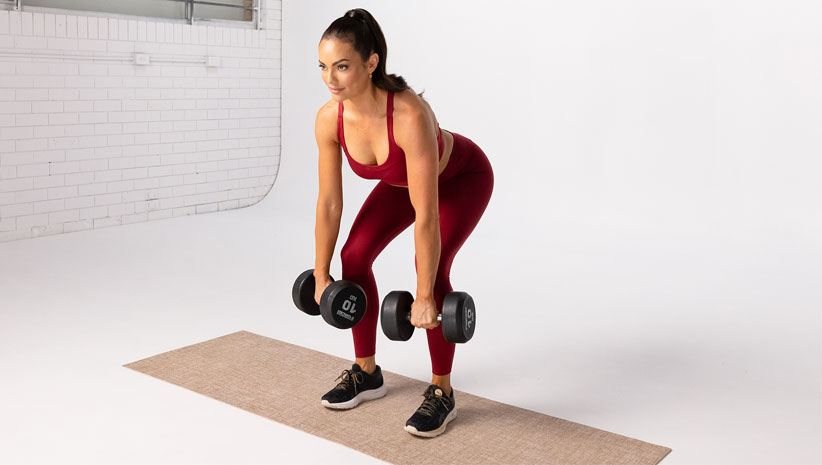How You Can Maintain Your Fitness as You Age

Emily Skye works her pelvic floor.
Menopause may signal the end of your periods, but does it mean the end of smashing a strong workout? Not a chance!
I’m here to tell you that women can and should continue to train, feel strong and crush their workouts into their 40s, 50s, 60s and beyond!
If you’re already experiencing it, you’ll know that there’s more to menopause than no more periods. There are different phases and symptoms, and the journey won’t be the same for everyone. That’s why I’ve teamed up with Dr. Jessica, physical therapist and part of my FIT crew, to show you how you can keep moving your body and benefiting from training as you move through perimenopause, menopause and beyond.
What is Perimenopause?
Perimenopause occurs when your body is nearing the end of its reproductive years and starts transitioning to menopause. This phase occurs at different ages for different women, starting as early as the late 30s for some, and (more often) in the early 40s for others.
What happens during Perimenopause?
As you go through this phase, your ovaries will start producing different levels of estrogen, which can make your menstrual cycle erratic or irregular.
Some signs you may be experiencing perimenopause include:
- Night sweats.
- Hot flashes.
- Mood changes.
- Incontinence.
- Vaginal dryness or pain with intercourse.
Dr. Jessica says it’s important to be aware of the changes you’re experiencing so you can remain proactive with your health.
“Remember, the contraceptive pill can mask the symptoms of perimenopause and menopause,” Dr. Jessica says. “As you get into your 40s, it’s a good idea to talk to your doctor about the best time to stop taking the pill or switch to a different form of contraception.”
Can exercise help with Perimenopause Symptoms?
According to Dr. Jessica, hormone changes during perimenopause will affect your musculoskeletal system.
“That means it’s more important than ever to stick to a regular strength training routine in order to slow down the rate of muscle and bone loss,” she says.
These changes can also spark weight gain and change.
Continuing to exercise will help you to do the following.
- Maintain muscle.
- Regulate cortisol (the stress hormone).
- Reduce fat storage.
- Minimize diabetes risk.
- Prevent aches and pains or future injuries.
“This phase is also a good time to introduce pelvic floor exercises into your routine, especially if you start to notice bladder leakage,” says Dr. Jessica.
“If you do experience incontinence or vaginal pain, you should seek help from a women’s health specialist or pelvic physiotherapist as soon as possible to prevent and reduce any future concerns. Unlike hot flashes or mood swings, these two symptoms often don’t go away on their own.”
Yoga (including pelvic floor work) is a great addition to any menopause exercise routine.

What if I don’t feel like exercising during perimenopause?
It might not always feel like it, but maintaining a regular training routine is one of the easiest ways to prevent and manage the mood changes that can come with perimenopause.
“Any form of exercise that increases endorphins and reduces stress or negative feelings will help you to manage the transition,” says Dr. Jessica. “It could be a sweaty strength session or taking a walk outside. Breathing exercises, meditation and listening to relaxing music can help, too.”
Changing sleep patterns during perimenopause can also feed into mood changes (and vice versa). Again, it’s crucial that you take a proactive approach for your mental health.
“Multiple studies show that light to moderate exercise before bed can actually help with restorative sleep,” Dr. Jessica adds.
Aim to do a lighter session at least 90 minutes before bed, keeping the more vigorous workouts for earlier in the day. (Unless you’re naturally a night owl, in which case you should work out when it works for you!) If you find yourself dealing with lethargy or sleep limitations, it’s important to try and identify the root cause. If it’s from poor dietary choices, lack of exercise or stress, focus on forming good habits in those areas to keep yourself feeling healthy and energized.
How Do I know when I’ve reached Menopause?
Once you have gone through a year without menstruation, you’ve fully transitioned to menopause. Most women will reach this phase between 45 and 55.
What’s the Best Kind of Exercise for Menopause?
Increasing evidence shows just how important regular physical activity is for increasing quality of life in general, but especially in middle age and beyond.
“During menopause, it’s even more important to stay regular with your strength training and focus on bigger muscle groups, doing activities you enjoy, and including restorative options like yoga or pilates,” Dr. Jesscia says.
“Moving your body also is shown to decrease pain for people with osteoarthritis and lower back pain.”

Emily Skye performs dumbbell deadlifts, a compound movement recommended for women going through menopause.
By continuing with proper strength training, you are able to put your muscle fibers under strain to help them adapt and maintain a level of strength that you won’t otherwise naturally have at this stage.
According to Dr. Jessica, your menopause exercise plan should focus on the following.
- Glutes.
- Quads.
- Back muscles.
- Compound movements such as squats and deadlifts.
Why are these areas so important to exercise?
“Loading your bones through resistance exercises also increases your body’s ability to create stronger bones to prevent the onset of osteoporosis,” Dr. Jessica says.
“The loading process triggers cell activity in the bones to keep reforming tissue, which reduces bones’ ability to bend or break.”
What if I don’t have the Energy to Exercise during Menopause?
Decreased energy or increased fatigue is common as your hormones change. However, one of the many well-researched benefits of exercise is the fact that it aids in reducing fatigue and increasing energy – yes, even in menopausal women. This is why sticking with a balance of strength training and restorative exercise is a great goal for menopause.
“In a recent study of physical activity levels and the effects of menopause on women, it was found that those who do moderate or vigorous levels of exercise regularly (3-5 days per week) experience less severe menopause symptoms,” Dr. Jessica says.
Whatever stage you’re at, don’t stop if you want to stay fit as you age!
In order to prioritize future well-being, it’s important that you create a lifestyle of healthy habits that you truly enjoy. It’s never too late to start (or enhance) your fitness goals.
“A regular strength training routine will continue to benefit you during post-menopause, reducing the effects of age-related illnesses such as arthritis and diabetes,” Dr. Jessica says.
“Training is also crucial to maintaining balance and coordination, which will reduce falls and prevent fractures, so you are able to retain your independence.”
How you feel can change from day to day, so keep moving with my Made to FIT workouts. It’s easy to filter for a low, medium or high intensity workout to suit your energy levels and strength. Having a high quality of life is so important, so don’t let any age-related changes make you feel like you can’t live and feel your absolute best!

Release the Pressure with this 7 Minute Meditation!
Emily Skye FIT
Check out the Emily Skye FIT app and emilyskyefit.com for more information and to start your 7-day free trial of the programs.
Emily Skye is a mother of two, strength training expert and the face of FIT, the digital fitness app that helps women worldwide build strength and confidence, stay active through pregnancy and rebuild post-pregnancy. Emily holds a Certificate IV in Fitness and Master Trainer qualification from the Australian Institute of Fitness.
